The level of humidity in the air greatly affects the well-being. During the heating season, air currents from radiators and electric heaters mercilessly dry up the already dry air. It's hard to be in such an atmosphere, it's hard to breathe and it's almost impossible to work, don't you agree? People with colds and allergy sufferers suffer even more, as the irritated mucous membrane of the respiratory tract and eyes becomes very sensitive to air quality.
Fortunately, these problems can be solved with the help of an ergonomic humidifier, which quickly replenishes the amount of moisture that is missing in the microclimate. However, like any technique, this device requires responsible maintenance. High-quality and suitable water for the device will not only extend its service life, but also have a beneficial effect on the health of households.
In this article we will tell you what kind of water to pour into the humidifier, consider the varieties of this technique and the principles of its work and find out how to independently prepare an acceptable liquid for refueling at home.
The content of the article:
- Why is air humidity important?
- Methods for checking the level of humidity in the air
-
Types of humidifiers and their functioning
- Type # 1 - steam humidifiers
- Type # 2 - cold-type humidifiers
- Type # 3 - ultrasonic humidifiers
- Humidifier water requirements
- Features of the preparation of distillate
- How to add water to the humidifier?
- Signs of using poor quality water
- How to humidify the air without a humidifier?
- Conclusions and useful video on the topic
Why is air humidity important?
Humidity is one of the key characteristics of indoor air quality. According to sanitary standards, an acceptable level of relative humidity in a room in the warm season is 30-60%, in the cold - 30-45%.
For children, doctors recommend raising this value to 50-60%, since a young developing organism is more sensitive to air parameters. We recommend that you familiarize yourself with the pros and cons of using humidifier for baby.
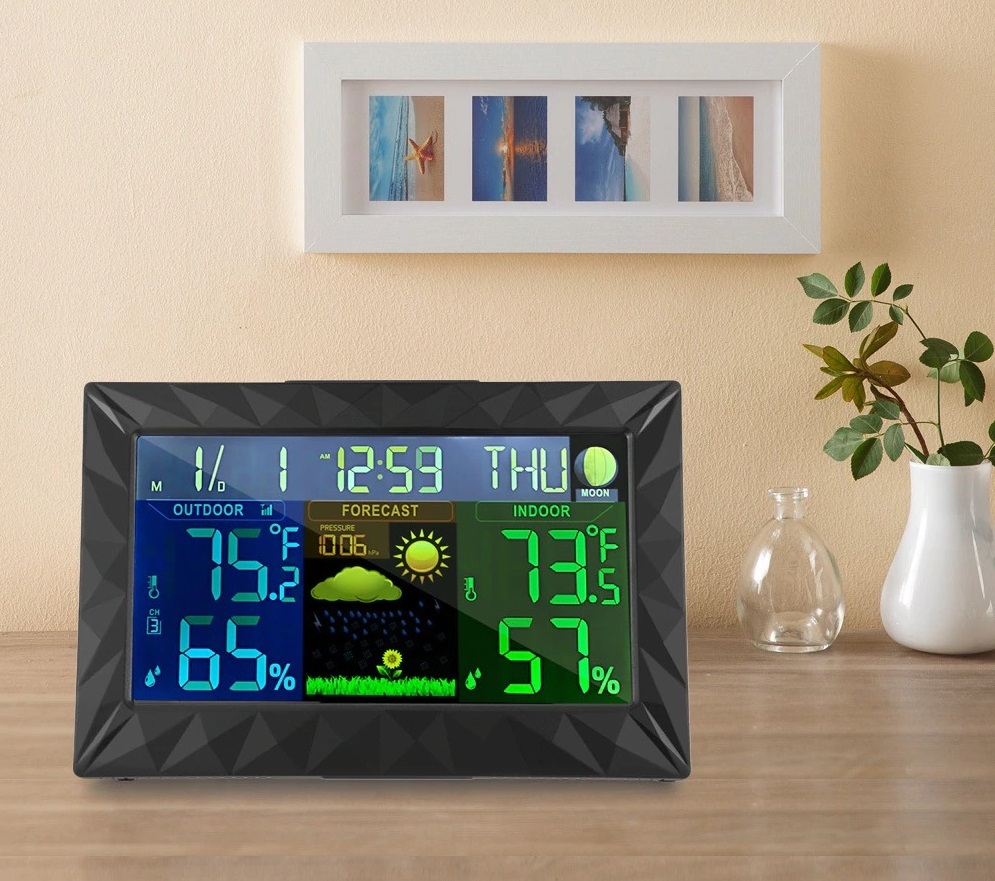
To measure moisture indicators, a special device is used - a hygrometer. However, purchasing it for home use is not entirely advisable. A much more profitable purchase will be a wireless weather station, which, in addition to air temperature and atmospheric pressure, also shows the level of relative humidity. Advanced models display information not only about weather conditions outside the home, but also analyze the microclimate in the room itself
The level of air humidity is quite clearly reflected in the state of the body:
- Excessively dry air becomes a companion of prolonged respiratory diseases - the depleted mucous surface cannot withstand viral or bacterial infection. Therefore, the healing process is delayed, and unwanted symptoms in the form of a runny nose and cough appear even brighter.
- Low humidity makes breathing difficult. Dizziness and other ailments can occur due to lack of oxygen. Concentrating on work in such an atmosphere is extremely difficult.
- Skin and hair are the first to suffer from dry air, losing their own moisture. The surface of the eyes also dries up, which makes the person uncomfortable.
Additionally, dry air can cause damage to wooden furniture, various finishing materials, musical instruments, and negatively affect indoor plants. During intensive operation of heating devices, the humidity level drops to at least 20%. To avoid these problems, you need to buy a suitable model of a humidifier and fill it with quality water.
Methods for checking the level of humidity in the air
The best way to check is to use hygrometer or weather stationreading information and indoors.
However, if such equipment is not available, you can approximately calculate the humidity level using the usual glasses of water.
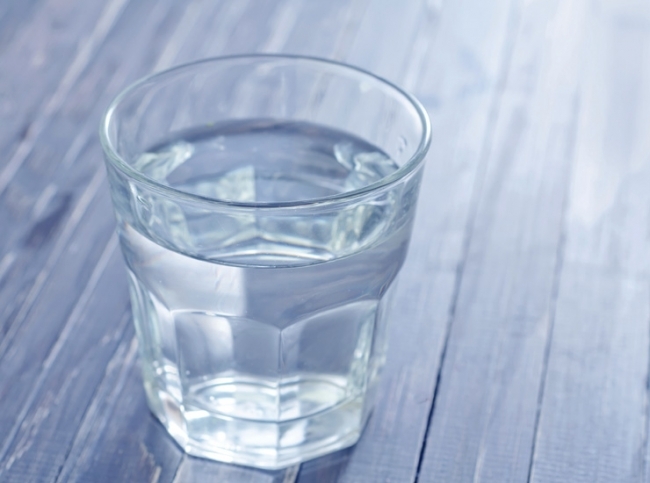
The glass method of checking the humidity level will not give specific percentages. However, in this way, you can clearly find out whether the microclimate in the room is sufficiently humid.
A glass beaker must be filled with cold water and placed in the refrigerator so that the temperature of the liquid drops to about 3-5 degrees Celsius. After that, the container is installed in the room at the maximum possible distance from the heating radiators.
If the glass becomes covered with condensation that dries up within five minutes, the humidity in the room is considered low. The average humidity is indicated by the persistence of condensation on the walls of the glass even after five minutes. If the glass is covered with small streams and drops, the humidity level in the room is increased, you do not need to buy a humidifier.
Types of humidifiers and their functioning
Manufacturers offer extremely ergonomic and functional models that work on slightly different principles. What exactly needs to be poured into an air humidifier fundamentally depends on the type of technology. There are several types of such devices on the market now.
Type # 1 - steam humidifiers
Steam humidifiers evaporate water through natural heating processes. The liquid is brought to a boil and then converted to steam.
These are the most effective models, however, they are not without certain disadvantages, among which are:
- high power consumption;
- the need to control the level of moisture.
However, some modifications can even be used as an inhaler, if a special nozzle is provided in the kit.
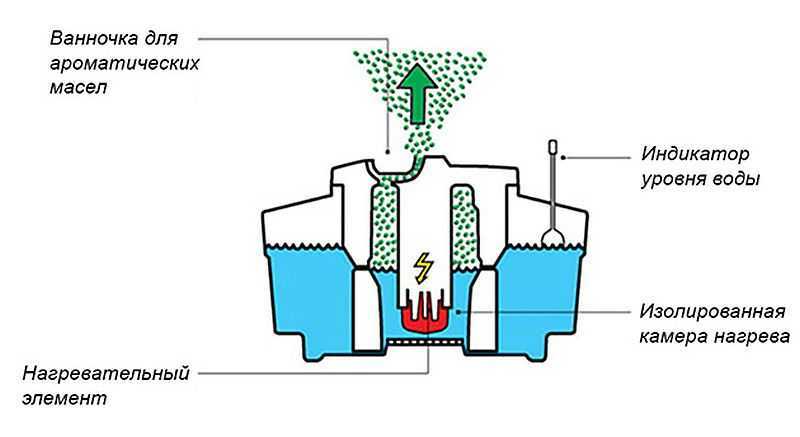
The principle of operation of a steam humidifier is shown in the diagram above. The design may include a separate compartment for oils. This allows you to make the air not only more humid, but also fragrant. Additionally, some essential oils, such as tea tree, have antibacterial properties that can neutralize airborne pathogens.
A significant advantage of such a humidifier is the low requirement of the device for water quality, so as any pure liquid is suitable for it: artesian, spring, demineralized or distilled. However, it is worth remembering that the generated steam will be inhaled by people, so you should not pour plain water into the humidifier from the common water supply system.
Type # 2 - cold-type humidifiers
Traditional cold-type humidifiers require special cartridges that saturate the blown air with the necessary moisture. Such models are filled with liquid, which the built-in fan drives through the cleaning unit.
Cartridges are extremely susceptible to clogging, so they must use distilled water, free of any impurities.
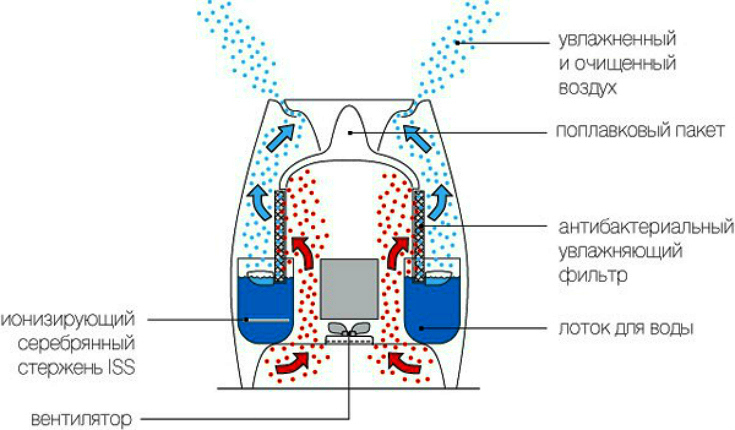
The diagram shows the device of a cold-type humidifier. In addition to the main components, the device can be equipped with an air ionizer, an additional antibacterial filter or even an ultraviolet lamp that also fights microorganisms
However, the cartridge still requires regular replacement: on average, it is updated at least once a quarter. If you do not use a distillate, the cartridge will partially remove impurities of heavy metal salts and make the water softer, but it will deteriorate faster.
Type # 3 - ultrasonic humidifiers
Ultrasonic models produce moisture due to mechanical vibrations on a special membrane. Water entering this unit is split into fine particles, which are carried away by the air flow generated by the fan. The process is carried out without heating, however, together with water, any impurities contained in the liquid are split into fractions.
Therefore, although the ultrasonic humidifier is extremely convenient and efficient, the device remains the most sensitive to water quality. Only a distillate is suitable for it, which does not contain any minerals or unwanted metals.
In more detail, the features of ultrasonic humidifiers, their pros and cons, we considered in this material.
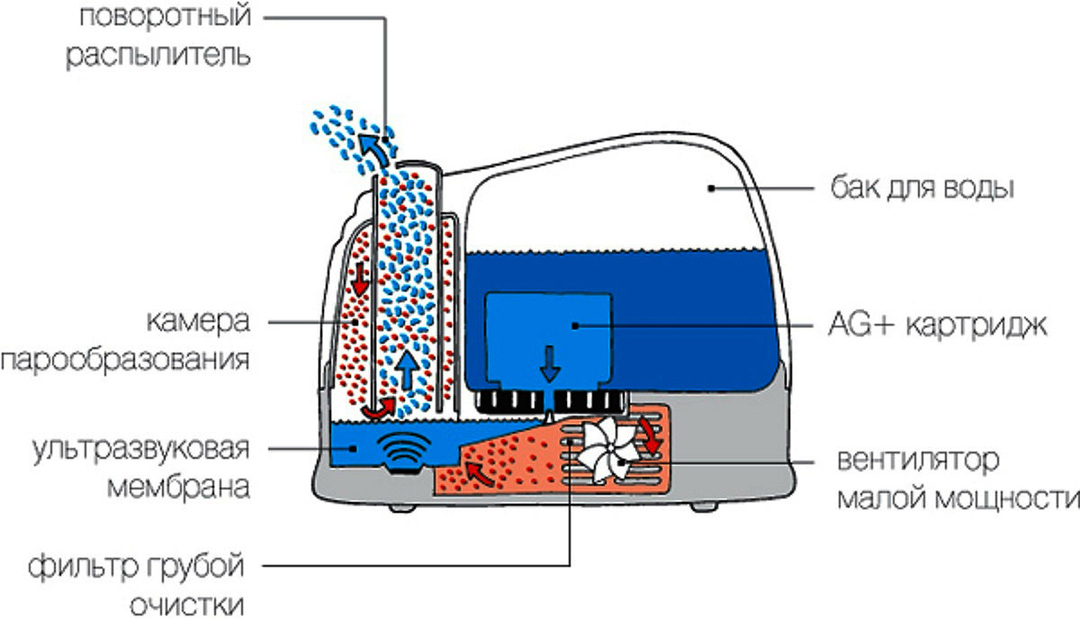
The figure shows the structure of the ultrasonic humidifier. In addition to the membrane, the device can have additional cartridges and coarse water filters, which increase the quality of the generated steam.
The most primitive and undemanding to water are spray humidifiers, which simply spray the smallest drops of water into the air. Any purified water is suitable for them, but do not forget about its characteristics, since microdroplets will enter the lungs.
Another type of humidifier is equipment with an air purification function. We talked more about humidifiers-purifiers in our next article.
Humidifier water requirements
As becomes clear from the above, the degree of purification and demineralization of water suitable for a particular humidifier depends on its type. Most often, manufacturers indicate this information in the passport for the device or instructions.
However, if ordinary bottled water is to be poured into the device, it is worth remembering that its particles will enter the body practically unchanged. With poor fluid quality, this can cause health problems.
Water has a lot of indicators, but hardness is the most important for a humidifier.
There are two types of water hardness:
- temporary characterized by the presence of magnesium and carbonate salts;
- constant - the presence of non-carbonate, for example, chlorides or sulfates.
Water with high temporary hardness during boiling forms a carbonate salt sludge. It is this that we observe on the surface of pots and in electric kettles after prolonged use.
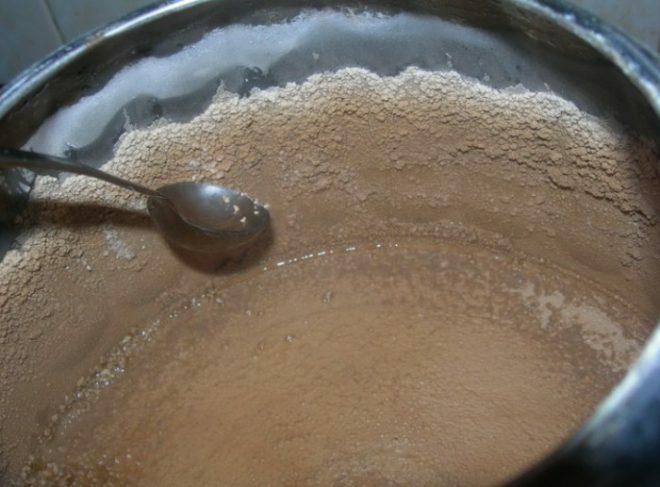
Scale on dishes is the main indicator of excessively hard water. It is definitely not worth using such a liquid for a humidifier.
Its softness directly depends on the temporary hardness of water. Constant hardness or chaliness already indicates the degree of mineralization of the liquid and characterizes its drinking quality.
Temporary hardness can be partially reduced by boiling or freezing. Additionally, high temperatures will kill viruses and pathogens. However, if the humidifier requires demineralized water, boiling will not help.
Water hardness is calculated in degrees of hardness ° W (° W = 1 mg-eq / l = 1/2 mol / m3):
- soft has indicators up to 2 ° F;
- medium hard - 2-10 ° W;
- tough - more than 10 ° J.
The normal hardness of water from a central source of water supply should not exceed 7 ° F, in some cases - 10 ° F. However, already at the level of 4-5 ° F, users will observe scale on dishes, a film on the surface of freshly brewed tea, stains on dishes, etc.
Therefore, such water is categorically not worth pouring even into an air humidifier that provides for the use of non-distilled water. The best solution for any humidifier is a distillate.
Features of the preparation of distillate
In order not to constantly buy distilled water for a household air humidifier, you can prepare it yourself. Such a distillate is suitable for all types of humidifiers and will be completely safe for households.
However, the process is quite lengthy and does not make it possible to obtain too much liquid at a time.
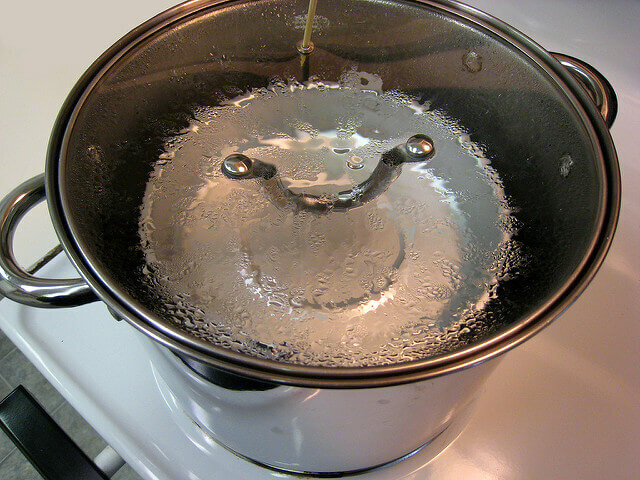
It is not necessary to use a special apparatus for distilling water at home. For these purposes, a saucepan with a concave lid is perfect.
To begin with, the water must be defended for 6-8 hours. During this time, volatile impurities, for example, hydrogen sulfide and chlorine, will be naturally removed, and heavy metal salts will sink to the bottom of the dishes used. It is this lower layer of liquid that must be carefully pumped out with a tube, removing about a third of the water.
After that, the water is ready for the distillation process, which is carried out in the following way:
- Pour settled water into an enamel pot, the volume of which is twice the volume of the prepared liquid.
- A grate is fixed above the water surface, on which a container for collecting the distillate is installed.
- The pan is covered with a concave lid, while the dome of the lid is directed towards the collection container.
- After that, the process of evaporation itself begins. After boiling, the water is converted into steam, which, settling on the surface of the lid, turns into water again and flows into a prepared container.
To speed up the distillation process, it is best to keep the lid surface cool constantly.
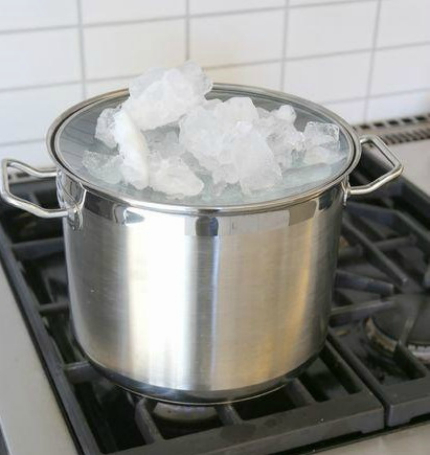
Ice is perfect for cooling the lid. Steam converts more quickly into purified water upon contact with a cold surface
After preparation, distilled water must be cooled and frozen. Part of the liquid that does not freeze must be drained off before use.
How to add water to the humidifier?
The filling of the humidifier with water always follows the instructions for the device. If the documents for the equipment are lost, you can look for the necessary information on the network or on the manufacturer's official website.
However, there are general principles for replacing water in the device, which should be observed by all owners:
- The remaining liquid in the reservoir must be completely drained.
- The water tank is thoroughly cleaned and washed.
- If there is scale deposits, it must be removed with a weak vinegar solution.
Such measures allow maintaining the maximum cleanliness of the humidifier tank, on which the safety of using the device largely depends.
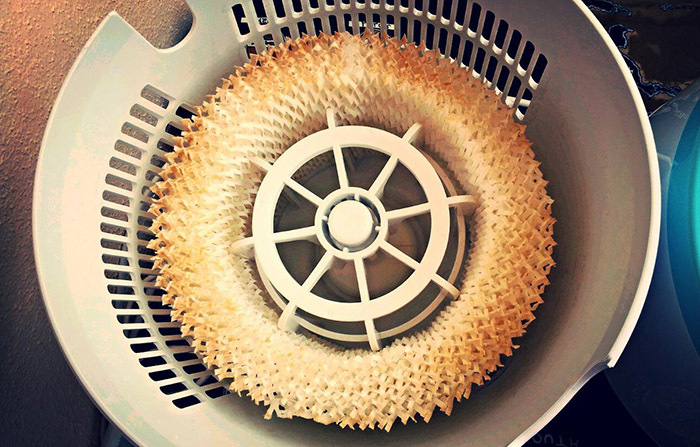
A contaminated filter must be replaced, since further use of a clogged membrane is harmful to health and may cause damage to the device.
If the container is not cleaned from dirt or mold, the humidifier must never be started. Spores and microorganisms from the humidifier can enter the air and cause certain diseases.
Signs of using poor quality water
You can understand that the water placed in the tank does not meet the requirements of the device by the following signs:
- the container smells unpleasant;
- residual water has changed color or become cloudy;
- pockets of mold or green plaque appeared on the walls;
- there is scale;
- an unaesthetic white coating has appeared on the furniture in the room.
Scale traces indicate an increased temporary water hardness, which can be removed by preliminary boiling. Mold and greenery indicate the presence of spores and bacteria in the water, which can be harmful to health. Plaque on furniture and other surfaces most often appears after the operation of ultrasonic humidifiers, during which, in addition to water, salts are also decomposed.
All these facts indicate that the choice and preparation of water for a humidifier must be approached more responsibly.
How to humidify the air without a humidifier?
Methods for increasing the level of humidity in a room without using a special humidifier are quite primitive, but still quite effective. These methods are suitable for the user if the device suddenly becomes unusable.
Let's take a closer look at these methods, and also recommend that you familiarize yourself with ten most popular models among users, so that you can choose a new humidifier to replace the broken one.
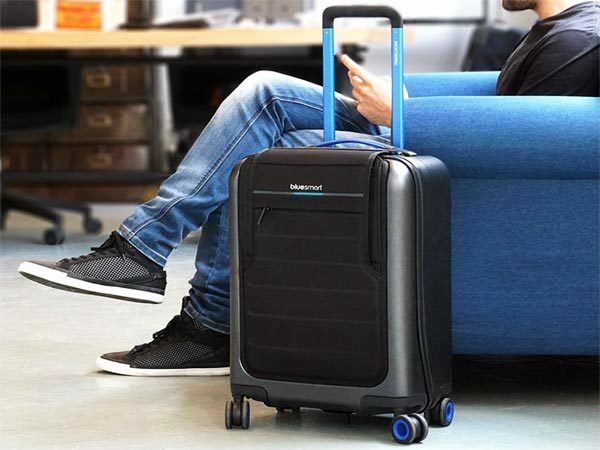
On a trip, when it is inconvenient to take additional equipment with you, knowledge about folk methods of increasing humidity will also not be superfluous.
To increase the level of humidity in the air, you can simply fill the pot with water and, after boiling, remove the lid, leaving the liquid to boil over low heat. However, it is worth monitoring the water level in the tank in order to avoid the occurrence of fire hazardous situations. To save gas, you can simply bring the water to a boil and then leave the pot on a windowsill or table.
Placing containers with water near heating appliances will also increase the humidity in the room. To maximize the effectiveness of these natural humidifiers, choose wide-necked pans as this will increase the evaporation area.
Drying clothes after washing directly in the room near the battery also increases humidity. However, it is worth remembering that clothes must be thoroughly rinsed out of detergents, since their components will also get into the air and lungs during evaporation. Additionally, the radiators can be covered with damp towels, which will also increase the relative humidity values.

Indoor plants also have a beneficial effect on the level of humidity. The most famous and unpretentious of them is chlorophytum. This lush flower effectively purifies the air and improves the microclimate.
Airing and wet cleaning is a guarantee of strong immunity and a way to neutralize the chances of getting a cold. The same mandatory measures improve the indoor microclimate in the room and increase the humidity to the required standards.
Opening the bathroom door after showering is another way to increase the humidity in your apartment. The fumes from the bathroom will move to other rooms, stabilizing the dry air. We looked at more ways to humidify the air without a humidifier in next article.
It is worth remembering, however, that all of these artisanal methods of increasing humidity can play a nasty joke on your health. If the humidifier evaporates high-quality purified water without unwanted impurities and pathogens, then in the above methods into the internal atmosphere home can get any bacteria or viruses, as well as salts of heavy metals, chlorine particles and other harmful elements contained in the usual water.
Conclusions and useful video on the topic
TOP 7 best air humidifiers are formed by the author of the video below. The review describes the key characteristics of the models, their advantages and disadvantages:
The process of preparing distilled water using a saucepan and a lid is clearly shown by the creator of the following video:
The difference resulting from the operation of an ultrasonic humidifier filled with distilled and ordinary water was revealed by the author of the video below. Using a special device, the content of undesirable impurities was recorded when using an ordinary liquid and their low level when pouring the distillate:
A humidifier is an almost indispensable device for the heating season, when the humidity level in the room drops to critically low values. Maintaining a favorable microclimate in housing will help avoid a number of health problems, improve the general condition of the body and improve the performance of people. Therefore, it is so important to pour high-quality, properly prepared water into the reservoir of the device, on which not only comfort, but also the well-being of a person will depend.
What type of humidifier do you use and what kind of water do you fill the tank with? Share your experience with other users operation of the humidifier. If you have questions or want to supplement the above material with useful information - leave your comments in a special block located below this publication.


